2007 SUBARU TRIBECA check transmission fluid
[x] Cancel search: check transmission fluidPage 134 of 377
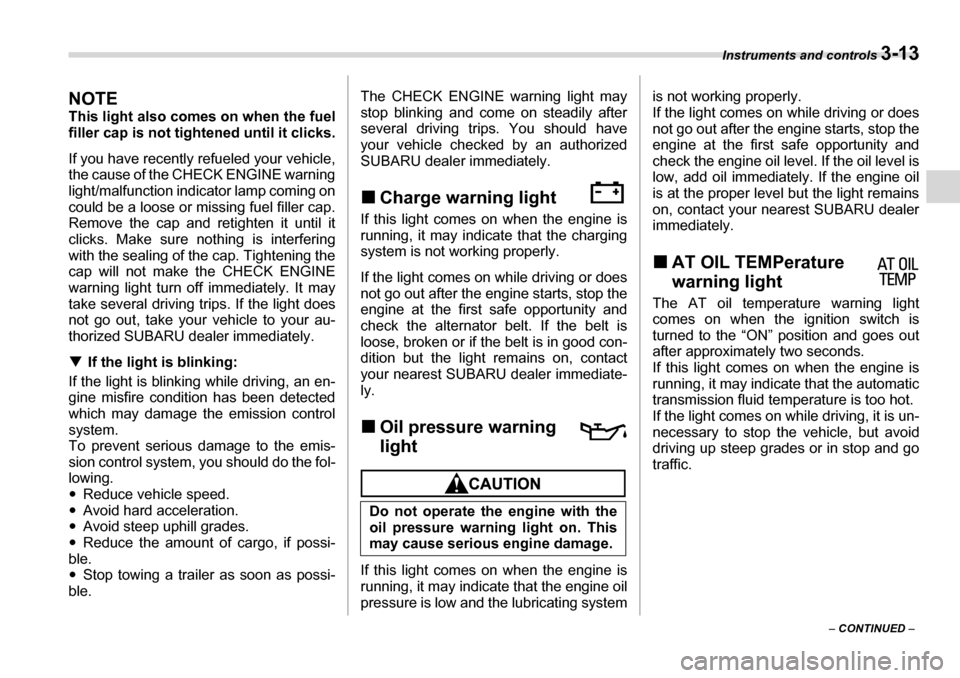
Instruments and controls 3-13
– CONTINUED –
NOTE
This light also comes on when the fuel
filler cap is not tightened until it clicks.
If you have recently refueled your vehicle,
the cause of the CHECK ENGINE warning
light/malfunction indicator lamp coming on
could be a loose or missing fuel filler cap.
Remove the cap and retighten it until it
clicks. Make sure nothing is interfering
with the sealing of the cap. Tightening the
cap will not make the CHECK ENGINE
warning light turn off immediately. It may
take several driving trips. If the light does
not go out, take your vehicle to your au-
thorized SUBARU dealer immediately. �TIf the light is blinking:
If the light is blinking while driving, an en-
gine misfire condition has been detected
which may damage the emission control system.
To prevent serious damage to the emis-
sion control system, you should do the fol-
lowing.�y Reduce vehicle speed.
�y Avoid hard acceleration.
�y Avoid steep uphill grades.
�y Reduce the amount of cargo, if possi-
ble.�y Stop towing a trailer as soon as possi-
ble. The CHECK ENGINE warning light may
stop blinking and come on steadily after
several driving trips. You should have
your vehicle checked by an authorized
SUBARU dealer immediately. �„
Charge warning light
If this light comes on when the engine is
running, it may indicate that the charging
system is not working properly.
If the light comes on while driving or does
not go out after the engine starts, stop the
engine at the first safe opportunity and
check the alternator belt. If the belt is
loose, broken or if the belt is in good con-
dition but the light remains on, contact
your nearest SUBARU dealer immediate-
ly. �„ Oil pressure warning light
If this light comes on when the engine is
running, it may indicate that the engine oil
pressure is low and the lubricating system is not working properly.
If the light comes on while driving or does
not go out after the engine starts, stop the
engine at the first safe opportunity and
check the engine oil level. If the oil level is
low, add oil immediately. If the engine oil
is at the proper level but the light remains
on, contact your nearest SUBARU dealer
immediately. �„
AT OIL TEMPerature
warning light
The AT oil temperature warning light
comes on when the ignition switch is
turned to the “ON” position and goes out
after approximately two seconds.
If this light comes on when the engine is
running, it may indicate that the automatic
transmission fluid temperature is too hot.
If the light comes on while driving, it is un-
necessary to stop the vehicle, but avoid
driving up steep grades or in stop and go
traffic.
Do not operate the engine with the
oil pressure warning light on. This
may cause serious engine damage.
Page 221 of 377
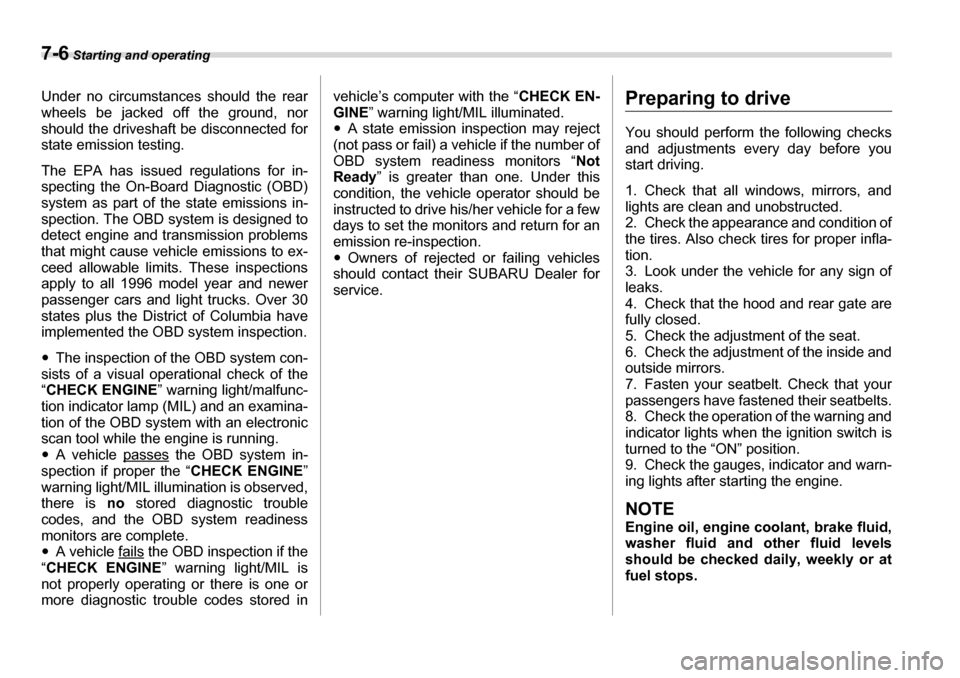
7-6 Starting and operating
Under no circumstances should the rear
wheels be jacked off the ground, nor
should the driveshaft be disconnected for
state emission testing. The EPA has issued regulations for in-
specting the On-Board Diagnostic (OBD)
system as part of the state emissions in-
spection. The OBD system is designed to
detect engine and transmission problems
that might cause vehicle emissions to ex-
ceed allowable limits. These inspections
apply to all 1996 model year and newer
passenger cars and light trucks. Over 30
states plus the District of Columbia have
implemented the OBD system inspection. �yThe inspection of the OBD system con-
sists of a visual operational check of the “ CHECK ENGINE ” warning light/malfunc-
tion indicator lamp (MIL) and an examina-
tion of the OBD system with an electronic
scan tool while the engine is running. �y A vehicle passes
the OBD system in-
spection if proper the “ CHECK ENGINE”
warning light/MIL illumination is observed,
there is no stored diagnostic trouble
codes, and the OBD system readiness
monitors are complete. �y A vehicle fails
the OBD inspection if the
“ CHECK ENGINE ” warning light/MIL is
not properly operating or there is one or
more diagnostic trouble codes stored in vehicle’s computer with the “
CHECK EN-
GINE ” warning light/MIL illuminated.
�y A state emission inspection may reject
(not pass or fail) a vehicle if the number of
OBD system readiness monitors “ Not
Ready ” is greater than one. Under this
condition, the vehicle operator should be
instructed to drive his/her vehicle for a few
days to set the monitors and return for an
emission re-inspection. �y Owners of rejected or failing vehicles
should contact their SUBARU Dealer for service.
Preparing to drive
You should perform the following checks
and adjustments every day before you
start driving.
1. Check that all windows, mirrors, and
lights are clean and unobstructed.
2. Check the appearance and condition of
the tires. Also check tires for proper infla-
tion.
3. Look under the vehicle for any sign of
leaks.
4. Check that the hood and rear gate are
fully closed.
5. Check the adjustment of the seat.
6. Check the adjustment of the inside and outside mirrors.
7. Fasten your seatbelt. Check that your
passengers have fastened their seatbelts.
8. Check the operation of the warning and
indicator lights when the ignition switch is
turned to the “ON” position.
9. Check the gauges, indicator and warn-
ing lights after starting the engine.
NOTE
Engine oil, engine coolant, brake fluid,
washer fluid and other fluid levels
should be checked daily, weekly or at
fuel stops.
Page 252 of 377
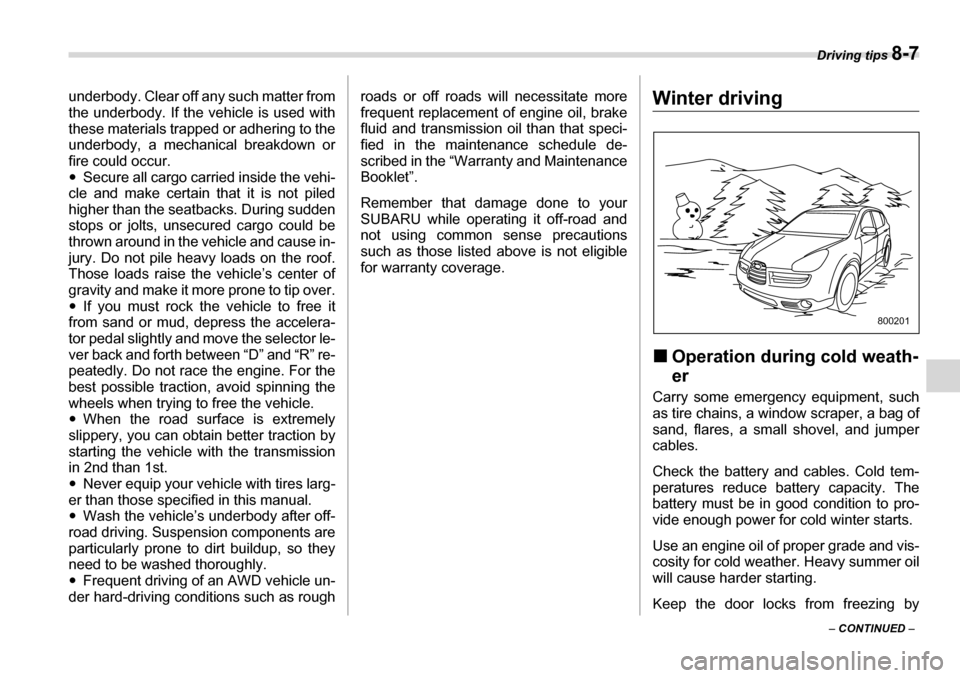
Driving tips 8-7
– CONTINUED –
underbody. Clear off any such matter from
the underbody. If the vehicle is used with
these materials trapped or adhering to the
underbody, a mechanical breakdown or
fire could occur. �y
Secure all cargo carried inside the vehi-
cle and make certain that it is not piled
higher than the seatbacks. During sudden
stops or jolts, unsecured cargo could be
thrown around in the vehicle and cause in-
jury. Do not pile heavy loads on the roof.
Those loads raise the vehicle’s center of
gravity and make it more prone to tip over. �y If you must rock the vehicle to free it
from sand or mud, depress the accelera-
tor pedal slightly and move the selector le-
ver back and forth between “D” and “R” re-
peatedly. Do not race the engine. For the
best possible traction, avoid spinning the
wheels when trying to free the vehicle. �y When the road surface is extremely
slippery, you can obtain better traction by
starting the vehicle with the transmission
in 2nd than 1st. �y Never equip your vehicle with tires larg-
er than those specified in this manual. �y Wash the vehicle’s underbody after off-
road driving. Suspension components are
particularly prone to dirt buildup, so they
need to be washed thoroughly. �y Frequent driving of an AWD vehicle un-
der hard-driving conditions such as rough roads or off roads will necessitate more
frequent replacement of engine oil, brake
fluid and transmission oil than that speci-
fied in the maintenance schedule de-
scribed in the “Warranty and Maintenance Booklet”.
Remember that damage done to your
SUBARU while operating it off-road and
not using common sense precautions
such as those listed above is not eligible for warranty coverage.
Winter driving �„
Operation during cold weath- er
Carry some emergency equipment, such
as tire chains, a window scraper, a bag of
sand, flares, a small shovel, and jumper cables.
Check the battery and cables. Cold tem-
peratures reduce battery capacity. The
battery must be in good condition to pro-
vide enough power for cold winter starts.
Use an engine oil of proper grade and vis-
cosity for cold weather. Heavy summer oil
will cause harder starting.
Keep the door locks from freezing by
800201
Page 298 of 377
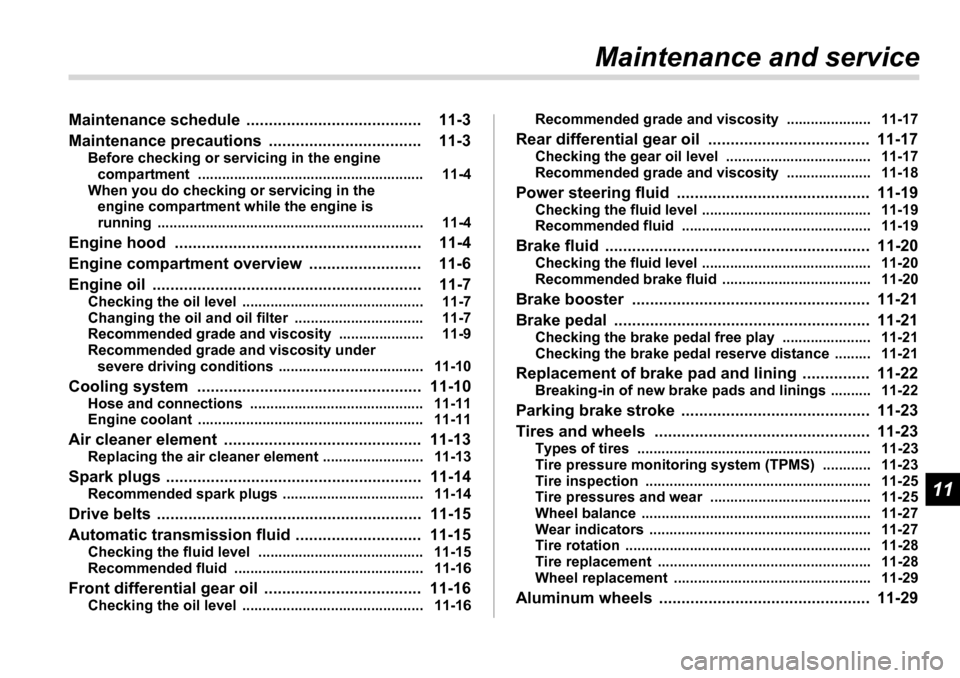
11
Maintenance and service
Maintenance schedule ....................................... 11-3
Maintenance precautions .................................. 11-3 Before checking or servicing in the engine compartment ........................................................ 11-4
When you do checking or servicing in the
engine compartment while the engine is
running .................................................................. 11-4
Engine hood ....................................................... 11-4
Engine compartment overview ......................... 11-6
Engine oil ............................................................ 11-7 Checking the oil level ............................................. 11-7
Changing the oil and oil filter ................................ 11-7
Recommended grade and viscosity ..................... 11-9
Recommended grade and viscosity under severe driving conditions .................................... 11-10
Cooling system .................................................. 11-10 Hose and connections ........................................... 11-11
Engine coolant ........................................................ 11-11
Air cleaner element ............................................ 11-13 Replacing the air cleaner element ......................... 11-13
Spark plugs ......................................................... 11-14 Recommended spark plugs ................................... 11-14
Drive belts ........................................................... 11-15
Automatic transmission fluid ............................ 11-15 Checking the fluid level ......................................... 11-15
Recommended fluid ............................................... 11-16
Front differential gear oil ................................... 11-16 Checking the oil level ............................................. 11-16 Recommended grade and viscosity ..................... 11-17
Rear differential gear oil .................................... 11-17 Checking the gear oil level .................................... 11-17
Recommended grade and viscosity ..................... 11-18
Power steering fluid ........................................... 11-19 Checking the fluid level .......................................... 11-19
Recommended fluid ............................................... 11-19
Brake fluid ........................................................... 11-20 Checking the fluid level .......................................... 11-20
Recommended brake fluid ..................................... 11-20
Brake booster ..................................................... 11-21
Brake pedal ......................................................... 11-21 Checking the brake pedal free play ...................... 11-21
Checking the brake pedal reserve distance ......... 11-21
Replacement of brake pad and lining ............... 11-22 Breaking-in of new brake pads and linings .......... 11-22
Parking brake stroke .......................................... 11-23
Tires and wheels ................................................ 11-23 Types of tires .......................................................... 11-23
Tire pressure monitoring system (TPMS) ............ 11-23
Tire inspection ........................................................ 11-25
Tire pressures and wear ........................................ 11-25
Wheel balance ......................................................... 11-27
Wear indicators ....................................................... 11-27
Tire rotation ............................................................. 11-28
Tire replacement ..................................................... 11-28
Wheel replacement ................................................. 11-29
Aluminum wheels ............................................... 11-29
Page 312 of 377
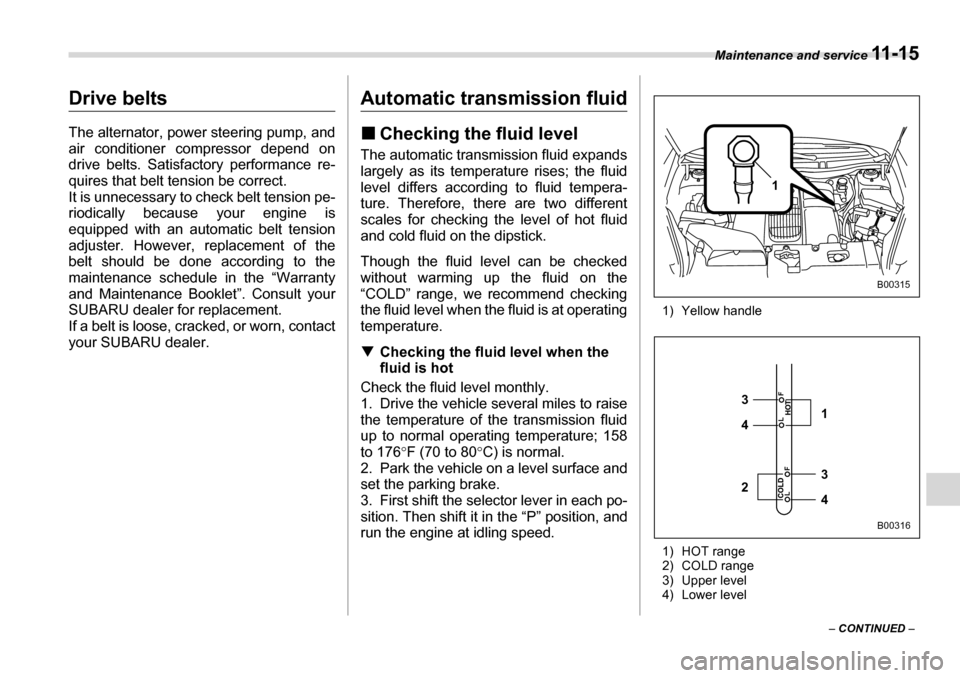
Maintenance and service 11 - 1 5
– CONTINUED –
Drive belts
The alternator, power steering pump, and
air conditioner compressor depend on
drive belts. Satisfactory performance re-
quires that belt tension be correct.
It is unnecessary to check belt tension pe-
riodically because your engine is
equipped with an automatic belt tension
adjuster. However, replacement of the
belt should be done according to the
maintenance schedule in the “Warranty
and Maintenance Booklet”. Consult your
SUBARU dealer for replacement.
If a belt is loose, cracked, or worn, contact
your SUBARU dealer.Automatic transmission fluid �„Checking the fluid level
The automatic transmission fluid expands
largely as its temperature rises; the fluid
level differs according to fluid tempera-
ture. Therefore, there are two different scales for checking the level of hot fluid
and cold fluid on the dipstick.
Though the fluid level can be checked
without warming up the fluid on the
“COLD” range, we recommend checking
the fluid level when the fluid is at operating
temperature. �T Checking the fluid level when the
fluid is hot
Check the fluid level monthly.
1. Drive the vehicle several miles to raise
the temperature of the transmission fluid
up to normal operating temperature; 158 to 176 °F (70 to 80 °C) is normal.
2. Park the vehicle on a level surface and
set the parking brake.
3. First shift the selector lever in each po-
sition. Then shift it in the “P” position, and
run the engine at idling speed. 1) Yellow handle
1) HOT range
2) COLD range
3) Upper level
4) Lower level
1
B00315
LF
LF
3 4
34 2
1
B00316
Page 313 of 377
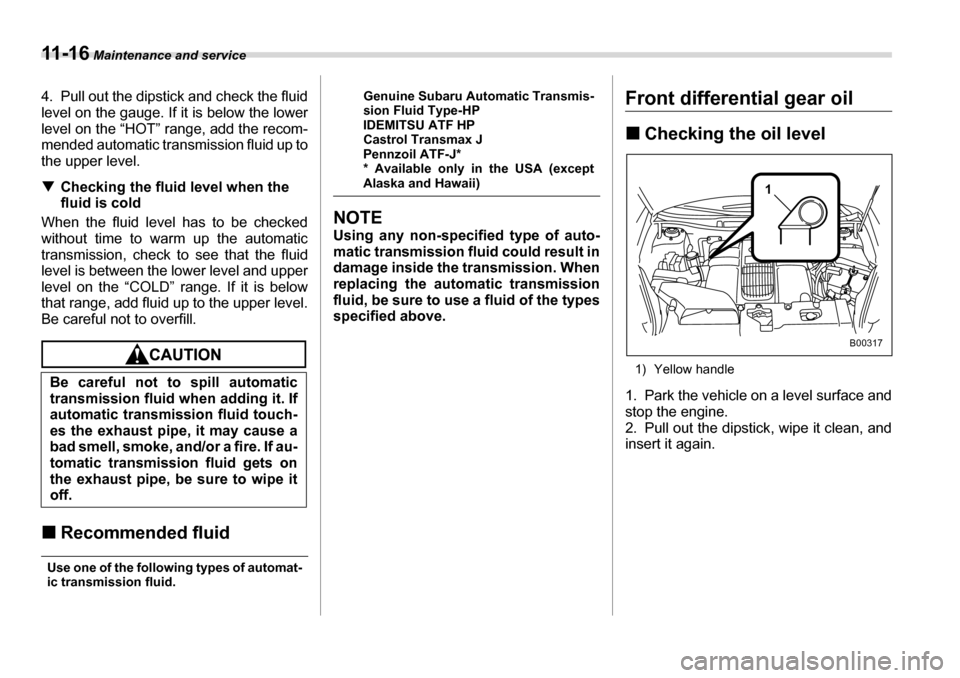
11 - 1 6 Maintenance and service
4. Pull out the dipstick and check the fluid
level on the gauge. If it is below the lower
level on the “HOT” range, add the recom-
mended automatic transmission fluid up to
the upper level. �TChecking the fluid level when the
fluid is cold
When the fluid level has to be checked
without time to warm up the automatic
transmission, check to see that the fluid
level is between the lower level and upper
level on the “COLD” range. If it is below
that range, add fluid up to the upper level.
Be careful not to overfill.
�„ Recommended fluid
Use one of the following types of automat-
ic transmission fluid. Genuine Subaru Automatic Transmis-
sion Fluid Type-HP
IDEMITSU ATF HP
Castrol Transmax J
Pennzoil ATF-J*
* Available only in the USA (except
Alaska and Hawaii)
NOTE
Using any non-specified type of auto-
matic transmission fluid could result in
damage inside the transmission. When
replacing the automatic transmission
fluid, be sure to use a fluid of the types
specified above.
Front differential gear oil �„
Checking the oil level
1) Yellow handle
1. Park the vehicle on a level surface and
stop the engine.
2. Pull out the dipstick, wipe it clean, and
insert it again.
Be careful not to spill automatic
transmission fluid when adding it. If
automatic transmission fluid touch-
es the exhaust pipe, it may cause a
bad smell, smoke, and/or a fire. If au-
tomatic transmission fluid gets on
the exhaust pipe, be sure to wipe itoff.
1
B00317